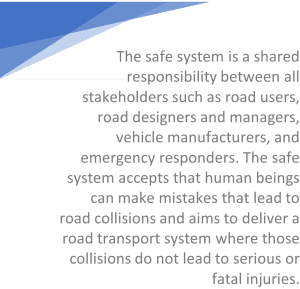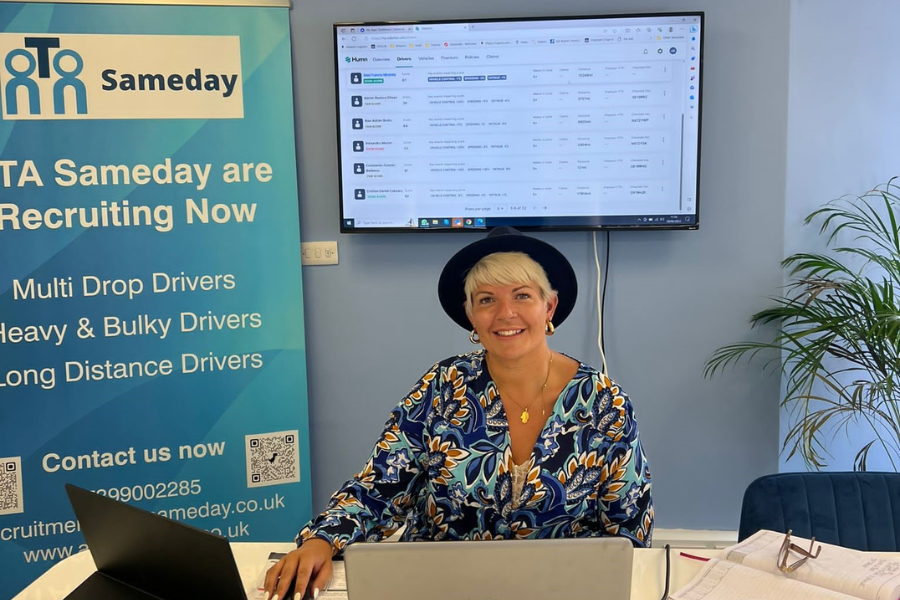Amanda Burch is Managing Director at ATA Sameday, a logistics provider insured by Humn – an official delivery partner for Driving for Better Business.
Amanda spoke to Dr Neale Kinnear, Head of Behavioural Science at Humn, about how ATA approach risk management.

Recent casualty data suggests that, on average, someone is injured on Great Britain’s roads every 4 minutes. Every 18 minutes, one of these will be fatal or serious, meaning that it will be life changing.
For anyone operating a fleet, this is the sobering reality of the risk their drivers and vehicles are exposed to each day. There are many factors that a fleet can’t control (e.g. road design, infrastructure, speed limits, other road users), but with the right policies, road risk assessments and use of data, operators can manage their fleets to reduce exposure and protect their drivers and the public.
Doing so also makes them an active part of what is called the ‘Safe System’, where everyone takes responsibility for road safety.
Why do you think it is important to manage road risk?
With the data we are collecting, we can identify risky behaviour. If we are not addressing it, we’re turning a blind eye and inadvertently saying its ok.
Road safety is not just about the driver on the road, but also putting practices in place to support them. For example, if I have a driver that was driving until 3am, we wouldn’t schedule them for a 9am start the next day, we’d ensure they have had enough of a break between shifts. We gather data each day so we can make better decisions. We can all improve safe practices simply by using insights derived from the data.
What data do you use to manage risk?
Everything, from shift reporting to telematics. Telematics is amazing and dependent on what system you use, you can really help limit potential risks on the road. You can pull reports quickly and efficiently and automate the distribution to the responsible teams to ensure the data is filtered through and actioned.
We run a fleet of 450 vans, and as a business owner, I don’t have time to look through everything but I have educated my staff to use the tools, set up the correct reports and send this data over to the drivers so that there is someone overseeing this important practice within our business.
Fleet operators often struggle with the amount of data available to them. How do you prioritise the data?
The report I look at daily is the top and bottom performing drivers. If I see a reoccurring name, I know we’re not using the data and consequently we’re putting risk out on the road. We use these daily reports to pick out the top performers and praise them for safe road practices, and even better when we see a driver go from bottom to top performer – we know our messages are getting heard loud and clear so it’s a win-win for everyone!
Can you give me an example of how you use telematics data with a driver?
We look at braking, harsh cornering etc. and make the effort to understand why with the driver. So, open up conversation. Something as simple as ‘Are you ok?’ rather than pointing out the bad things.
Drivers are on their own 90% of the day and working alone can have mental strains on anyone. Maybe they have something going on outside of work that has clouded their judgement on that particular day which has affected their driving. Sometimes, and more often than not, someone asking that simple question can make the world of difference to an individual and really shows that as a business you care for each individual and you often learn the reason behind their driving behaviour.
What difference has using data made to your fleet?
Huge! Simple, one worded answer there! Most importantly – less risk on the road! Can you run your business without insurance? If the answer to this is, no, then this is why using the data is so important. Unfortunately, crashes happen, fault and non-fault, but can you sit there and honestly say that you have done everything you can to limit unnecessary risks on the road? Have I educated my staff on the risks of not using the data? Am I close to my insurance company and do they know my practices so that if I do have a claim they know this isn’t common practice for us?
Can you afford year-on-year for your premiums to get higher and higher? No, so let’s work together to reduce those costs.
As a business owner you must have a lot of priorities, why do you feel risk management is one of them?
I hear this all the time when speaking to businesses. Yes, we are all busy. Life is super busy but If I am honest, my business wouldn’t exist if life wasn’t busy because we would all have time to go to the shops and logistics companies like mine wouldn’t exist!
As a business we make the time to prioritise putting practices into place. Finding the time now to put the right practices in place to ensure you are using the data, will save you time further down the line, along with money and potentially even a life.
Ultimately, why do you take this approach?
Collectively we have to do this for it to make an impact. If we don’t act now, the premiums will keep getting higher and higher. I have first-hand experience of the difference in running a fleet and using the data correctly to when I didn’t! I really am passionate about this and really want to make it right. I have seen someone die in front of me on the road and I never want anyone to experience it. Everyone deserves to come home at night. Remember, it could be someone’s son, daughter, mother, father, friend.
It’s simple, use your data and limit the risk.






